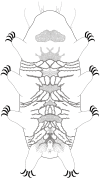High Mountain Echiniscid (Heterotardigrada) Fauna of Taiwan
- PMID: 35774252
- PMCID: PMC9169119
- DOI: 10.6620/ZS.2021.60-70
High Mountain Echiniscid (Heterotardigrada) Fauna of Taiwan
Abstract
Taiwan lies at the transitional zone between the East Palaearctic and Oriental regions, which translates into both Palaearctic and Indomalayan taxa being present on the island. Furthermore, large habitat heterogeneity and high mountains contributed to the rise of conditions favouring allopatric speciation and the emergence of endemic species. The tardigrade fauna of Taiwan is poorly studied, and the aim of this contribution is to provide new data on the members of the family Echiniscidae, the largest limno-terrestrial group of the class Heterotardigrada, found at high elevations in central Taiwan. We report 11 species grouped in 5 genera: Claxtonia (1 species), Echiniscus (3 species), Hypechiniscus (1 species), Nebularmis (2 species), and Pseudechiniscus (4 species). All are new to Taiwan, including 5 species that are new to science, 4 or which are described herein by means of integrative taxonomy: Hypechiniscus crassus sp. nov. (the exarmatus morphogroup), Pseudechiniscus (Meridioniscus) dreyeri sp. nov., Pseudechiniscus (Pseudechiniscus) formosus sp. nov., and Pseudechiniscus (Pseudechiniscus) totoro sp. nov. The new findings also help to clarify the description of Echiniscus clevelandi Beasley, 1999, and supplement the phylogenies of the Echiniscus virginicus complex and of the genera Hypechiniscus, Nebularmis and Pseudechiniscus.
Keywords: Biogeography; Endemism; Integrative taxonomy; Oriental; Palaearctic; Phylogeny.
Figures































References
-
- Abe W, Ito M, Takeda M. 2000. First record of Echiniscus hoonsooi (Tardigrada: Echiniscidae) from Japan. Spec Divers 5:103–110. doi:10.12782/specdiv.5.103.
-
- Beasley CW. 1999. A new species of Echiniscus (Tardigrada, Echiniscidae) from Northern Yunnan Province, China. Zool Anz 238:135–138.
-
- Casquet JT, Thebaud C, Gillespie RG. 2012. Chelex without boiling, a rapid and easy technique to obtain stable amplifiable DNA from small amounts of ethanol-stored spiders. Mol Ecol Resour 12:136–141. doi:10.1111/j.1755-0998.2011.03073.x. - PubMed
-
- Cesari M, Montanari M, Kristensen RM, Bertolani R, Guidetti R, Rebecchi L. 2020. An integrated study of the biodiversity within the Pseudechiniscus suillus–facettalis group (Heterotardigrada: Echiniscidae). Zool J Linn Soc 188:717–732. doi:10.1093/zoolinnean/zlz045.
-
- Dastych H. 1980. Niesporczaki (Tardigrada) Tatrzańskiego Parku Narodowego. Monogr Faun Pol 9:1–232.
LinkOut - more resources
Full Text Sources
